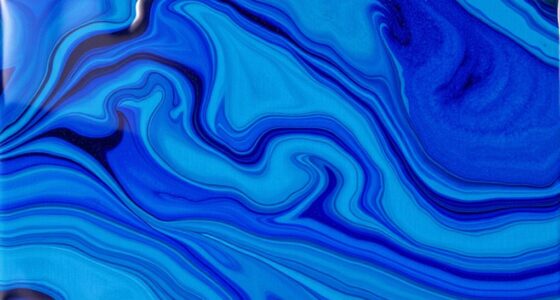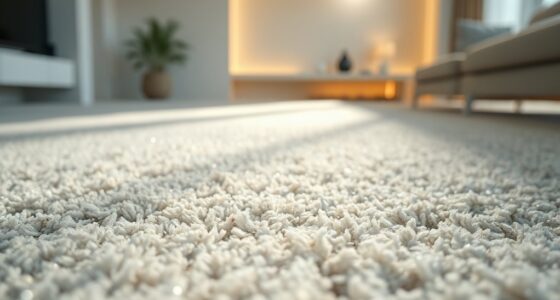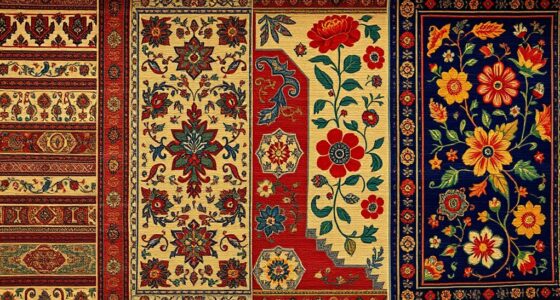When you get a new wool rug, some shedding of fibers is normal, especially in the first few weeks or months. This happens as the fibers loosen and settle into place, and manufacturing processes like dyeing can also cause some fibers to come loose. To reduce shedding, gently vacuum without a beater bar and care for the rug properly. If you want to know how to manage shedding long-term and spot signs of excess, keep exploring.
Key Takeaways
- Initial shedding is normal during the first few weeks as loose fibers settle and fibers tighten.
- Shedding varies based on rug construction, with hand-tufted and looser weaves shedding more initially.
- Proper gentle vacuuming without a beater bar helps reduce shedding over time.
- Shedding decreases as fibers become denser and settle into their final position.
- Persistent or excessive shedding beyond a few months may indicate a quality or manufacturing issue.
Understanding Wool Fiber Shedding
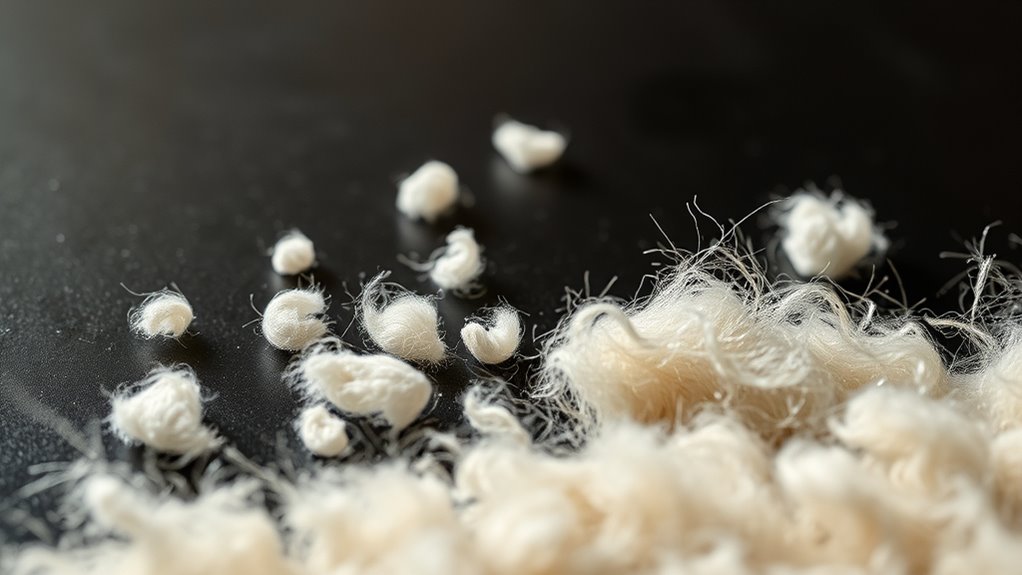
Wool fiber shedding is a common phenomenon that occurs because wool fibers are naturally prone to loosening and releasing from the rug’s surface. This shedding is often influenced by how the wool was processed during manufacturing, especially through wool dyeing and fiber treatments. Wool dyeing can affect the fiber’s surface, sometimes making fibers more likely to loosen initially. Fiber treatments, such as finishing or coating, are designed to improve durability but may also impact shedding behavior. It’s important to understand that some shedding is normal, especially with new wool rugs, as fibers settle and the surface fibers loosen. Proper care and gentle cleaning can help minimize shedding over time, ensuring your rug remains beautiful and functional. Additionally, understanding the processing methods used can help set realistic expectations for shedding and longevity. Being aware of fiber quality can also help predict how much shedding to expect and how long it might last. Recognizing the manufacturing process can further assist in understanding variations in shedding among different wool rugs.
Reasons Behind Initial Shedding
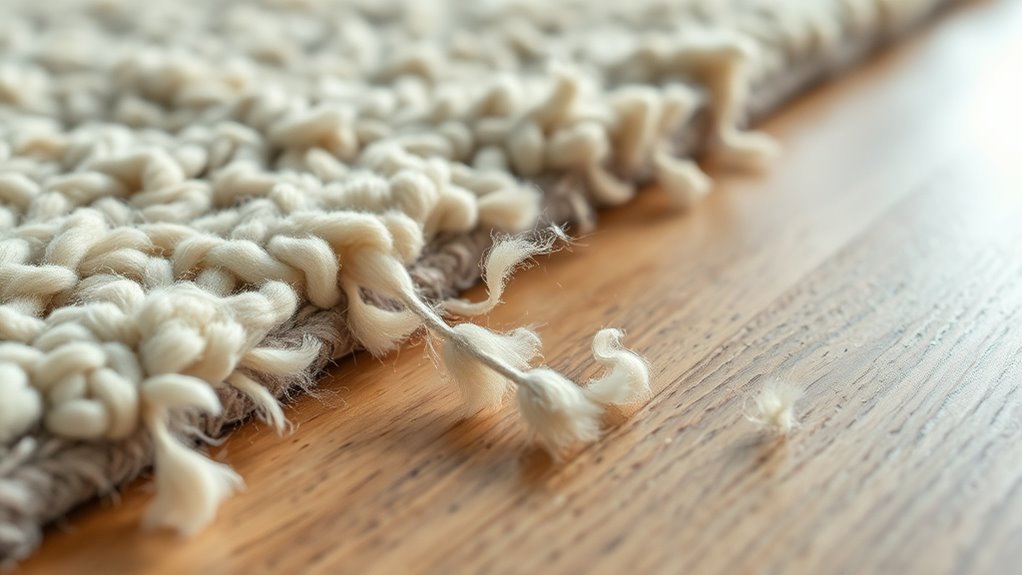
You might notice loose fibers coming off your rug at first, which is often just excess fibers being shed. This initial shedding is also influenced by the manufacturing process, where some fibers may not be fully secured. Understanding these factors can help you manage the shedding during your rug’s early days. Additionally, fiber quality plays a role in the amount of shedding, as higher-quality wool tends to shed less over time. Moreover, air purifier features such as filtration technology and manufacturing standards are vital in ensuring that products meet safety and quality benchmarks, which can indirectly relate to fiber quality control.
Loose Fiber Removal
Loose fiber removal during the initial phase of using a wool rug happens because manufacturing processes and handling can leave behind surface fibers that haven’t fully settled. These loose fibers are often visible and may come off easily when you vacuum or brush the rug. The dye color used in the rug can also influence shedding, as some dyes may cause fibers to loosen initially. Proper furniture placement can help minimize additional shedding by reducing friction in high-traffic areas, which can pull loose fibers loose. This initial shedding is normal and typically subsides after a few weeks of regular cleaning. To keep shedding minimal, avoid aggressive vacuuming and use gentle methods. Additionally, fiber types can impact how noticeable shedding appears in different lighting conditions, especially if the rug contains natural wool fibers known for their softness and tendency to shed temporarily. Recognizing that manufacturing imperfections can contribute to early shedding can help set expectations and guide proper care during the initial weeks. Remember, this phase is temporary and part of the rug’s natural settling process.
Manufacturing Process Effects
The manufacturing process plays a significant role in initial wool rug shedding. During dyeing, uneven dye fading can weaken fibers, making them more prone to shedding. If dyes bleed during production, it indicates that colorfastness wasn’t fully achieved, which can result in loose fibers coming loose over time. Additionally, improper sealing or finishing techniques may leave fibers less secure, increasing shedding. These issues are often most noticeable at the start, as loose fibers shed until the rug stabilizes. Manufacturing inconsistencies, like rough handling or inadequate fiber bonding, also contribute to initial shedding. While some shedding is normal, understanding how dye fading and color bleeding relate to the process helps you recognize whether shedding is a manufacturing concern or something that will lessen with use. Moreover, the presence of fiber deterioration during production can accelerate shedding, emphasizing the importance of quality control measures in manufacturing.
How Much Shedding Is Typical?
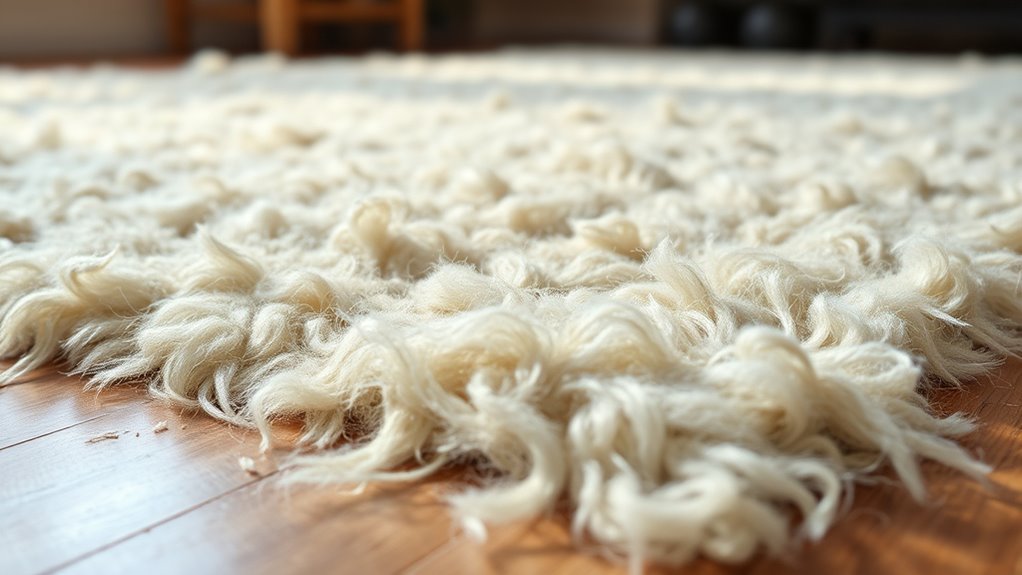
How much shedding is considered normal for wool rugs? Typically, a small amount of fiber shedding occurs during the first few weeks of use. You might notice loose fibers on the surface, especially after vacuuming or foot traffic. This shedding is often related to fiber coloration, as new wool still releases loose fibers until the dyeing process stabilizes. Rug sizing also influences shedding; larger rugs tend to shed more simply because they have more surface area and fibers. Additionally, some shedding may be linked to fiber type and quality, which can affect how much fiber is released initially. However, excessive or persistent shedding beyond a few weeks could indicate lower-quality wool or manufacturing issues. Keep in mind that some shedding is a natural part of breaking in a new wool rug, but monitoring the amount helps determine if it’s within normal limits.
Differences Between New and Older Rugs
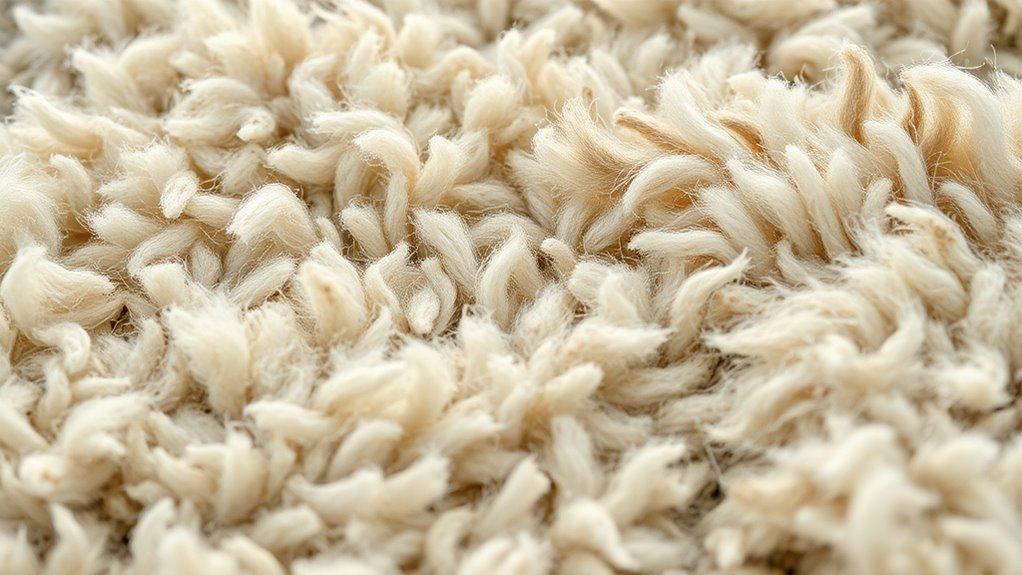
When you first get a new wool rug, expect more shedding during the initial phase as loose fibers work their way out. Over time, the fiber density increases, reducing the amount of loose fibers you see. As the rug ages, wear and aging cause fibers to loosen again, but the shedding typically stays less than in the beginning.
Initial Shedding Phase
New wool rugs often shed more fibers initially than their older counterparts because the manufacturing process leaves loose fibers on the surface. During this initial shedding phase, you might notice fibers on your clothing or furniture. This is normal and usually lasts a few weeks. As the fibers shed, watch for dye bleeding or color fading, which can occur if the rug isn’t fully stabilized. To visualize, imagine:
- Loose fibers drifting like dust motes in sunlight.
- Small tufts gathering along edges or in corners.
- Faint color smudges on your hands after touching the rug.
This shedding isn’t a sign of poor quality but part of the natural break-in process. After some time, shedding will diminish, revealing a more stable, durable rug that maintains its vibrant color and texture.
Fiber Density Changes
As the fibers shed during the initial phase, you’ll notice that the overall density of the wool in your rug begins to change over time. This reduction in fiber density makes the rug feel slightly less plush and more transparent in certain areas. You might also observe subtle differences in dye consistency, as older rugs often develop uneven coloration due to fading or wear. Color fading is natural, especially in rugs exposed to sunlight or cleaning agents, which can alter the vibrancy of the original dyes. These changes don’t indicate damage but reflect the rug’s aging process. Additionally, the fiber quality of the wool can influence how much shedding occurs and how quickly the rug settles into its mature appearance. Over time, the fiber density stabilizes, and shedding decreases, giving you a clearer picture of the rug’s true condition and longevity, which can be affected by factors like fiber density changes and exposure to environmental elements.
Wear and Aging Effects
Over time, wear and aging visibly distinguish older wool rugs from newer ones. As rugs age, dye stability decreases, leading to subtle color fading and uneven dye migration. This process can cause areas to appear duller or slightly different in hue. You might notice:
- Faded colors and less vibrant patterns
- Slight discoloration due to dye migration
- Reduced fiber resilience, making fibers feel softer or more fragile
These changes reflect the natural aging process, not necessarily shedding issues. While dye migration can alter appearance, it doesn’t typically increase fiber shedding. Instead, older rugs develop a patina that speaks to their history. Understanding these effects involves recognizing the aging process and how it influences appearance. Dye stability and other factors can influence the aging process and overall appearance. Attention to these subtle signs can help you better care for and maintain your rug’s beauty over time.
Signs That Shedding Is Excessive
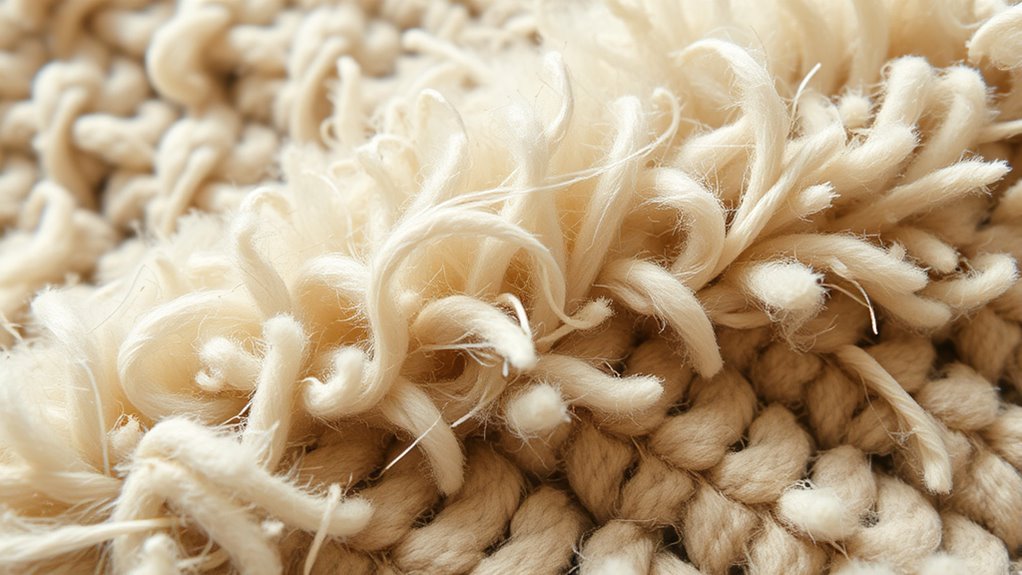
Excessive shedding in wool rugs is often noticeable through persistent fibers on furniture, clothing, or floors beyond the usual amount. If shedding continues well after the initial few weeks, it could signal a problem. One sign is loose fibers that come away easily during cleaning or vacuuming, especially if they seem to be from the rug’s surface rather than embedded fibers. Poor fiber dyeing can also contribute, causing color bleeding and increased fiber loss. Additionally, if you notice fibers coming loose from areas with inadequate rug padding or where the rug is poorly secured, shedding may be excessive. These signs suggest that the shedding isn’t just normal break-in but might indicate underlying issues affecting the rug’s durability or quality. Digital literacy programs can help you better understand and care for your textiles and home furnishings. Moreover, understanding payment processing methods can assist in managing online shopping transactions for your home needs safely and securely.
The Role of Rug Construction and Weaving Techniques
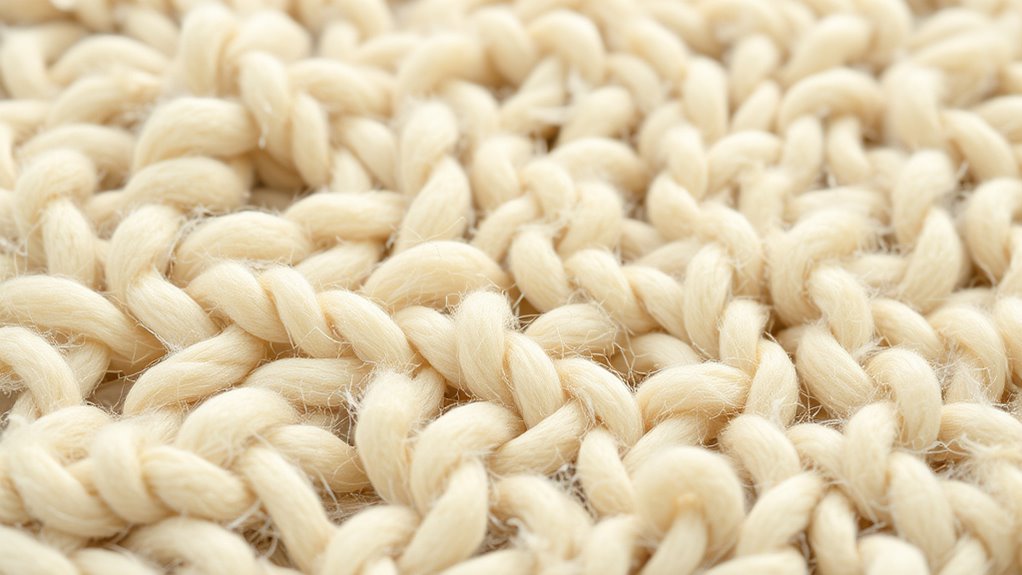
The way your rug is constructed and woven directly affects how much fiber sheds. Tighter weaving and denser materials usually reduce shedding and improve durability. Understanding these techniques helps you select rugs that stay looking fresh longer.
Weaving Methods Impact Shedding
Different weaving methods markedly influence how much wool sheds from a rug. For example, hand-tufted rugs tend to shed more initially, while tightly woven flatweaves shed less. Think of it like:
- A shaggy, plush pile that releases fibers with every step.
- A densely woven rug resistant to dye fading and color bleeding, remaining vibrant longer.
- An open-weave design that traps loose fibers, reducing shedding over time.
In looser weaves, fibers are less securely held, leading to increased shedding and potential dye fading or color bleeding. Conversely, tight weaves hold fibers firmly, minimizing shedding and maintaining color integrity. Your choice of weaving method directly impacts how long your rug looks new and how much fiber ends up on your floor.
Rug Material Density
Rug material density plays a vital role in how much wool sheds from your rug, as denser constructions hold fibers more securely. When a rug has high density, loose fibers are minimized, reducing shedding over time. Conversely, less dense rugs may shed more fibers initially, especially in new rugs. You might also notice dye bleeding or color fading if the rug isn’t tightly woven, as loose fibers can carry dyes that bleed during cleaning or exposure to moisture. Maintaining proper density helps preserve the rug’s appearance and minimizes shedding. It’s important to choose rugs with appropriate density for your space and care routines. Dense rugs tend to shed less and maintain their color vibrancy longer, making them a practical choice for reducing fiber loss and enhancing durability.
Construction Stability Factors
Construction stability hinges on how a rug is woven and assembled, directly influencing its durability and fiber retention. The way fibers are aligned and secured affects shedding and dye bleeding. Consider these factors:
- Tightness of the weave: A tightly woven rug prevents fibers from loosening and reduces shedding.
- Knot density: Higher knot counts create a more stable structure, improving fiber retention and minimizing fiber loss.
- Fiber quality: Premium wool with strong, consistent fibers resists breakage and dye bleeding, ensuring longevity and vibrant colors.
Poor construction or low-quality fibers can cause excessive shedding and dye bleeding, especially if the dye isn’t properly set. Understanding these construction stability factors helps you choose rugs that stay beautiful longer and shed less over time.
Tips to Minimize Shedding During Break-In Period
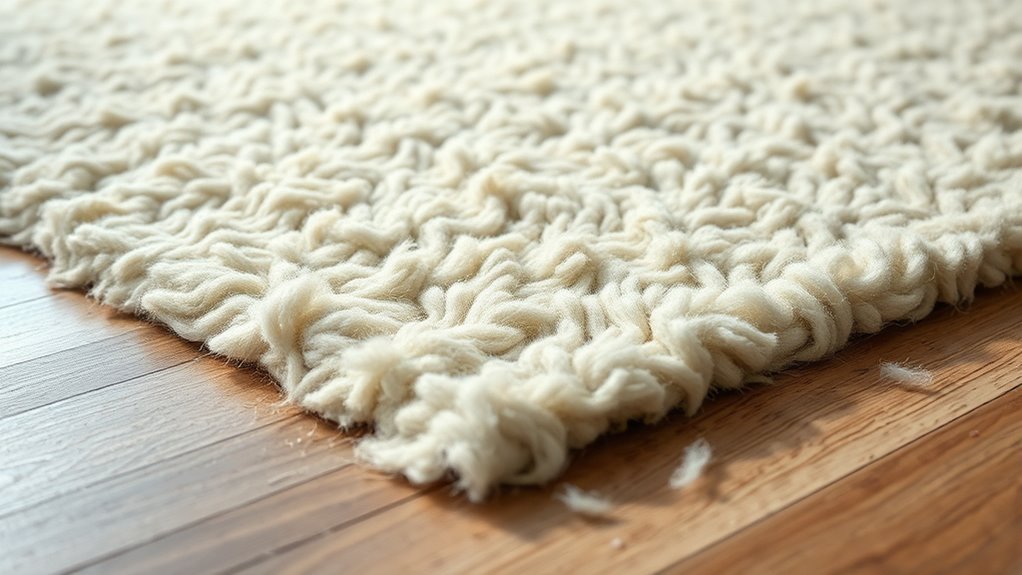
To reduce fiber shedding during the break-in period, it is vital to handle your wool rug carefully and follow some simple maintenance tips. Start by placing your rug on a well-padded surface or using quality rug padding to prevent unnecessary friction that can loosen fibers. When unrolling or moving the rug, avoid dragging it, which can disturb the wool fibers. If your rug has been wool dyed, be aware that excess dye can sometimes contribute to shedding; allow it to settle by giving it time before heavy use. Regularly vacuum gently without using a beater bar to lift loose fibers. These practices help minimize shedding, preserve your rug’s appearance, and support the natural settling process of the wool fibers during the break-in period.
Proper Maintenance and Cleaning Practices
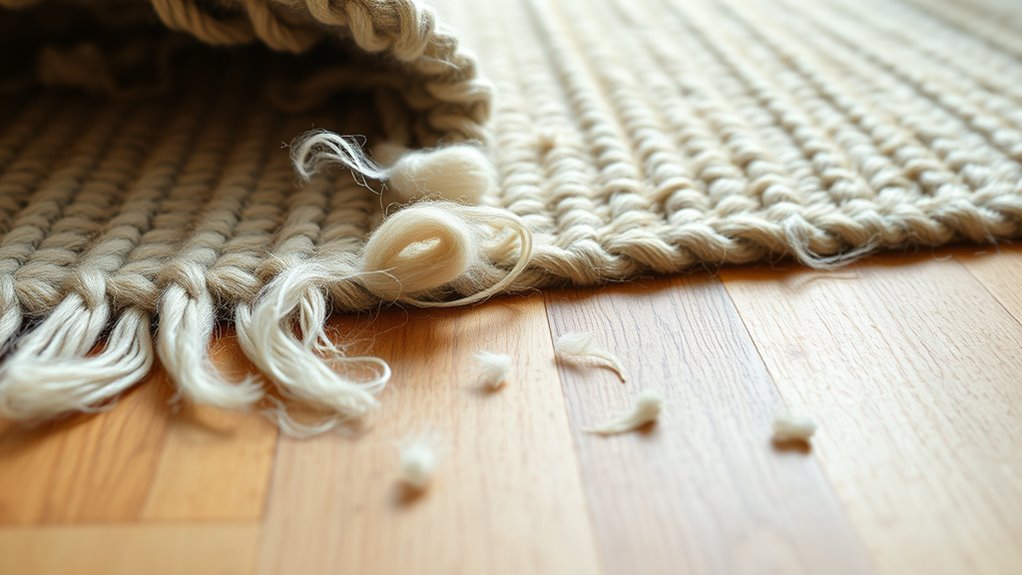
Proper maintenance and cleaning are essential to keep your wool rug looking its best and to minimize ongoing shedding. Regular care helps prevent issues like dye fading and color bleeding, which can occur if dirt and debris build up. To keep your rug in top condition:
- Gently vacuum with a suction-only attachment to remove loose fibers without damaging the pile.
- Spot clean spills immediately using cold water and a mild detergent to prevent dye fading and stains.
- Rotate your rug periodically to ensure even wear and prevent uneven shedding or fading.
Avoid harsh chemicals and excessive scrubbing, which can weaken fibers and cause dye bleeding. Proper maintenance preserves your rug’s vibrant color and minimizes fiber loss over time.
When to Seek Professional Advice
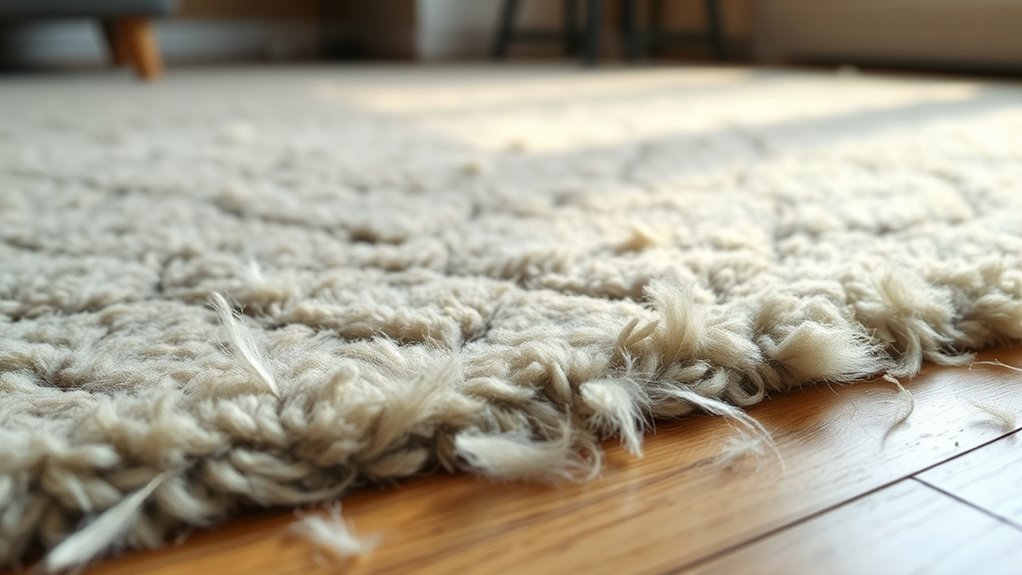
While regular maintenance can considerably reduce shedding, it’s important to recognize when professional advice becomes necessary. If your wool rug continues shedding excessively despite proper cleaning, it may indicate issues with fiber quality or dye stability. Poor fiber quality can cause fibers to break or loosen prematurely, making shedding worse. Similarly, unstable dyes can weaken fibers, leading to increased fiber loss. If you notice persistent shedding beyond the initial break-in period, or if fibers appear damaged or discolored, consulting a rug specialist is advisable. They can assess whether the rug’s construction or materials are contributing to the problem. Addressing these issues early helps preserve your rug’s appearance and longevity, ensuring you get the most value from your investment.
Long-Term Care for Wool Rugs
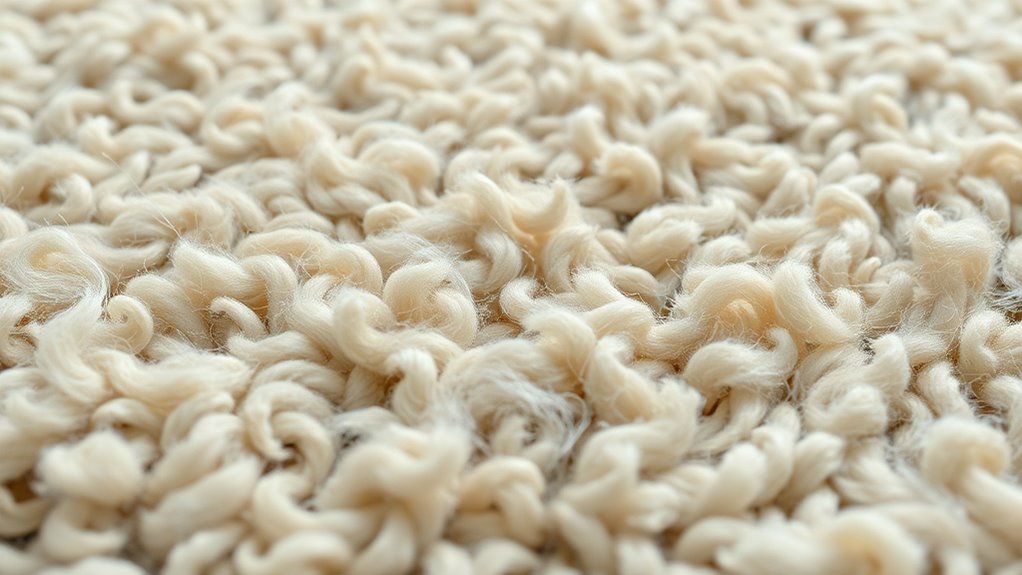
Maintaining your wool rug over the long term requires consistent care to preserve its appearance and durability. To prevent issues like dye bleeding and color fading, follow these steps:
Long-term wool rug care keeps colors vibrant and fibers strong.
- Regularly vacuum with a gentle suction to remove dirt that can cause fibers to weaken and shed.
- Rotate your rug periodically to ensure even wear and prevent uneven fading or dye loss.
- Avoid placing your rug in direct sunlight, which accelerates color fading and may cause dyes to seep over time.
Frequently Asked Questions
Does Fiber Shedding Indicate a Defect or Poor Quality Rug?
You might wonder if fiber shedding means your rug is defective or of poor quality. In most cases, shedding is normal, especially for new wool rugs, and it relates to fiber quality and rug construction. As fibers settle, shedding decreases. To minimize it, regularly vacuum and follow care instructions. Persistent excessive shedding could suggest lower fiber quality or poor rug construction, so inspect your rug and consider professional advice if needed.
Can Environmental Factors Increase Wool Shedding?
Environmental factors can definitely stir up wool shedding, like wind rattling leaves in a forest. You might notice more pet hair or loose fibers after exposure to drafts, sunlight, or humidity. While manufacturing defects can cause excessive shedding initially, changes in your environment can temporarily increase fiber loss. Keep your rug clean and avoid extreme conditions, and you’ll help minimize shedding, ensuring your wool rug stays beautiful and cozy.
Are There Specific Rug Dyes That Cause More Shedding?
You might notice that certain rug dyes cause more shedding, especially if the dye chemical isn’t fully fixed or if there are colorfastness issues. Bright, vivid colors often use more dye, increasing the chance of excess dye particles shedding. To reduce this, look for rugs with dyes known for better stability, and consider professional cleaning or gentle washing to help minimize dye-related shedding and keep your rug looking its best.
How Does Foot Traffic Affect Shedding Over Time?
Some believe heavy foot traffic accelerates wool fiber shedding, but studies show rug durability actually improves with regular use. When you walk on a wool rug, the fibers settle and compact, reducing loose fibers over time. While initial shedding may be higher, consistent foot traffic helps the fibers lock in place, leading to less shedding long-term. So, your daily activity can promote a more durable, less shedding wool rug.
Is Shedding Worse in Certain Room Temperatures or Humidity Levels?
You might notice that shedding varies with room temperature and humidity levels. Warmer, more humid environments tend to keep wool fibers more flexible, reducing shedding. Conversely, dry, cool air can cause fibers to become brittle and shed more easily. To minimize shedding, keep your room at a moderate temperature and maintain balanced humidity levels. Regularly vacuum and brush your rug to help fibers stay intact and reduce loose fibers.
Conclusion
As your wool rug settles into your space, think of shedding as its gentle lullaby—part of its journey to maturity. With patience and proper care, this initial fluff will quiet, revealing the lush, resilient beauty beneath. Keep up with regular cleaning and watch for any signs of excess. Soon, your rug will become a steadfast companion, woven with stories and warmth, shedding its early whispers to stand strong and soft under your every step.


